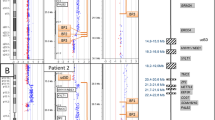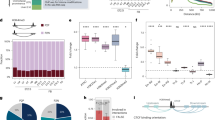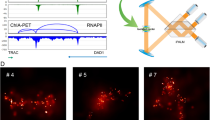Abstract
We report the characterisation of a de novo supernumerary chromosome marker in a mosaic state (50%) by comparative genomic hybridisation (CGH) in an 8-year-old child with hypotonia, dysmorphia and mild-to-moderate mental retardation. We describe the combined use of CGH and fluorescence in situ hybridisation (FISH) to identify the origin of the additional chromosomal material. Visual analysis of 10 CGH-metaphase spreads revealed a gain of green fluorescent signal on pericentromeric region of chromosome 17. The CGH finding was confirmed by FISH analysis using a whole chromosome 17 paint, a chromosome 17 centromeric probe and the probe coding for the Smith–Magenis locus in 17p11.2. These results show that performing both CGH and FISH in combination with classical karyotyping will certainly allow the identification of imbalanced chromosome rearrangements and, by the way, allow the identification of genes involved in mental retardation and/or malformative pathology.
Similar content being viewed by others
Log in or create a free account to read this content
Gain free access to this article, as well as selected content from this journal and more on nature.com
or
References
Levy B, Gershin IF, Desnick RJ et al: Characterization of a de novo unbalanced chromosome rearrangement by comparative genomic hybridization and fluorescence in situ hybridization. Cytogenet Cell Genet 1997; 76: 68–71.
Bryndorf T, Kirchhoff M, Rose H et al: Comparative genomic hybridization in clinical cytogenetics. Am J Hum Genet 1995; 57: 1211–1220.
Ghaffari SR, Boyd E, Connor JM, Jones AM, Tolmie JL : Mosaic supernumerary ring chromosome 19 identified by comparative genomic hybridisation. J Med Genet 1998; 35: 836–840.
Levy B, Jalal SM, Dunn TM et al: Unique case of mosaicism involving two morphologically similar marker chromosomes of different centric origin in a patient with developmental delay. Am J Med Genet 2002; 108: 198–204.
Stankiewicz P, Park S-S, Holder SE et al: Trisomy 17p10–p12 resulting from a supernumerary marker chromosome derived from chromosome 17: molecular analysis and delineation of the phenotype. Clin Genet 2001; 60: 336–344.
Rooney DE, Czepulkowski BH : Human cytogenetics: a practical approach. New York: Oxford University Press, 1992.
Kallioniemi A, Kallioniemi OP, Sudar D et al: Comparative genomic hybridization for molecular cytogenetic analysis of solid tumors. Science 1992; 258: 818–820.
Benzacken B, Lapierre JM, Siffroi JP, Chalvon A, Tachdjian G : Identification and characterization of a de novo partial trisomy 10p by comparative genomic hybridization (CGH). Clin Genet 1998; 54: 334–340.
Morelli SH, Deubler DA, Brothman LJ, Carey JC, Brothman AR : Partial trisomy 17p detected by spectral karyotyping. Clin Genet 1999; 55: 372–375.
Kozma C, Meck JM, Loomis KJ, Galindo HC : De novo duplication of 17p [dup(17)(p12–p11.2)]: report of an additional case with confirmation of the cytogenetic, phenotypic, and developmental aspects. Am J Med Genet 1991; 41: 446–450.
Micci F, Teixeira MR, Bjerkehagen B, Heim S : Characterization of supernumerary rings and giant marker chromosomes in well-differentiated lipomatous tumors by a combination of G-banding, CGH, M-FISH and chromosome -and locus-specific FISH. Cytogenet Genome Res 2002; 97: 13–19.
Rosenberg C, Borovik CL, Canonaco RS, Sichero LC, Queiroz APS, Vianna-Morgante AM : Identification of a supernumerary marker derived from chromosome 17 using FISH. Am J Med Genet 1995; 59: 33–35.
Wiktor A, Van Dyke DL, Weiss L : Characterization of a de novo 48,XX, +r(X), +r(17) by in situ hybridization in a patient with neurofibromatosis (NF1). Am J Med Genet 1993; 45: 22–24.
Morrison PJ, Smith NM, Martin KE, Young ID : Mosaic partial trisomy 17 due to a ring chromosome identified by fluorescence in situ hybridisation. Am J Med Genet 1997; 68: 50–53.
Shaeffer LG, McCaskill C, Hersh JH, Greenberg F, Lupski JR : A clinical and molecular study of mosaicism for trisomy 17. Hum Genet 1996; 97: 69–72.
Martsolf JT, Larson L, Jalal SM, Wasdahl WA, Miller R, Kukolich M : Complete trisomy 17p a relatively new syndrome. Ann Genet 1988; 31: 172–174.
Lupski JR, Wise CA, Kuwano A et al: Gene dosage is a mechanism for Charcot–Marie–Tooth disease type 1A. Nat Genet 1992; 1: 29–33.
Veltman JA, Schoenmakers EF, Eussen BH et al: High-throughput analysis of subtelomeric chromosome rearrangements by use of array-based comparative genomic hybridization. Am J Hum Genet 2002; 70: 1269–1276.
Author information
Authors and Affiliations
Corresponding author
Rights and permissions
About this article
Cite this article
Dupont, C., Pipiras, E., Chantot-Bastaraud, S. et al. CGH and direct diagnosis of mosaic structural chromosomal abnormalities: description of a mosaic ring chromosome 17 and review of the literature. Eur J Hum Genet 11, 452–456 (2003). https://doi.org/10.1038/sj.ejhg.5200984
Received:
Revised:
Accepted:
Published:
Issue date:
DOI: https://doi.org/10.1038/sj.ejhg.5200984



